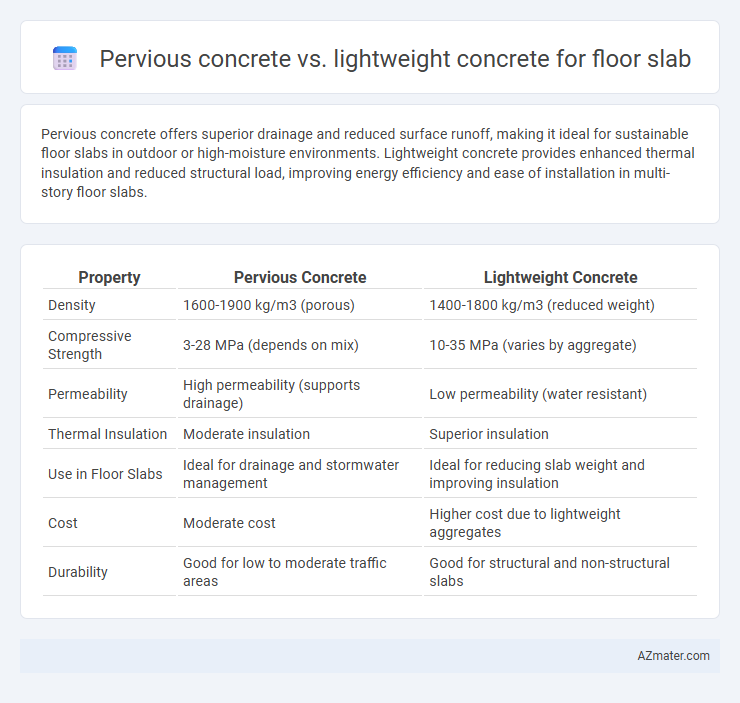Pervious concrete offers superior drainage and reduced surface runoff, making it ideal for sustainable floor slabs in outdoor or high-moisture environments. Lightweight concrete provides enhanced thermal insulation and reduced structural load, improving energy efficiency and ease of installation in multi-story floor slabs.
Table of Comparison
| Property | Pervious Concrete | Lightweight Concrete |
|---|---|---|
| Density | 1600-1900 kg/m3 (porous) | 1400-1800 kg/m3 (reduced weight) |
| Compressive Strength | 3-28 MPa (depends on mix) | 10-35 MPa (varies by aggregate) |
| Permeability | High permeability (supports drainage) | Low permeability (water resistant) |
| Thermal Insulation | Moderate insulation | Superior insulation |
| Use in Floor Slabs | Ideal for drainage and stormwater management | Ideal for reducing slab weight and improving insulation |
| Cost | Moderate cost | Higher cost due to lightweight aggregates |
| Durability | Good for low to moderate traffic areas | Good for structural and non-structural slabs |
Introduction to Floor Slab Materials
Pervious concrete offers enhanced drainage capabilities through its porous structure, making it ideal for floor slabs in environments requiring water permeability and stormwater management. Lightweight concrete, composed with expanded aggregates, reduces structural load and improves thermal insulation properties, benefiting floor slabs in multi-story buildings and energy-efficient designs. Choosing between pervious and lightweight concrete depends on specific project needs, balancing factors such as load capacity, drainage, and insulation performance.
Overview of Pervious Concrete
Pervious concrete is a highly porous material designed to allow water infiltration, making it ideal for sustainable floor slab applications where stormwater management is critical. Compared to lightweight concrete, which emphasizes reduced density and thermal insulation, pervious concrete offers superior permeability and environmental benefits by reducing runoff and promoting groundwater recharge. Its porous structure is achieved by minimizing fine aggregates, resulting in enhanced drainage capacity while maintaining adequate structural strength for floor slabs.
Overview of Lightweight Concrete
Lightweight concrete, characterized by its reduced density and enhanced thermal insulation properties, is made using lightweight aggregates such as expanded clay, shale, or slate. It offers significant advantages for floor slabs, including lower dead loads, improved fire resistance, and better workability compared to conventional concrete. This type of concrete is increasingly preferred in construction for its ability to reduce structural load while maintaining adequate strength and durability.
Key Differences Between Pervious and Lightweight Concrete
Pervious concrete offers high permeability, allowing water to pass through the slab and reducing runoff, making it ideal for sustainable urban drainage systems, while lightweight concrete provides enhanced insulation and reduced structural load due to its lower density. Pervious concrete typically has a compressive strength range of 3.5 to 28 MPa and consists of coarse aggregates with minimal fines to maintain porosity, whereas lightweight concrete uses materials like expanded clay or shale to achieve densities as low as 1440 kg/m3 with strengths varying from 7 to 35 MPa. The key difference lies in their application focus: pervious concrete emphasizes permeability and environmental benefits, whereas lightweight concrete targets thermal performance and structural efficiency in floor slab construction.
Structural Performance Comparison
Pervious concrete offers enhanced drainage capabilities while maintaining adequate compressive strength typically ranging from 3,000 to 4,000 psi, making it suitable for floor slabs requiring water permeability without significant load-bearing demands. Lightweight concrete, with densities between 90 to 115 lb/ft3 and compressive strengths often exceeding 4,000 psi, provides superior structural performance and thermal insulation for floor slabs under heavier loads. The choice between pervious and lightweight concrete depends on balancing permeability needs against load capacity and durability requirements for floor slab applications.
Durability and Longevity Factors
Pervious concrete offers excellent durability in floor slabs due to its high permeability, which reduces hydrostatic pressure and minimizes freeze-thaw damage, enhancing longevity in climates with frequent moisture fluctuations. Lightweight concrete provides improved durability by reducing dead load and thermal conductivity, which helps mitigate cracking and structural fatigue over time. Both materials require proper mix design and curing practices to maximize lifespan, with pervious concrete best suited for environments demanding efficient drainage and lightweight concrete excelling in seismic or load-sensitive applications.
Thermal and Acoustic Insulation Properties
Pervious concrete offers superior acoustic insulation due to its porous structure, which effectively absorbs sound waves, making it ideal for noise reduction in floor slabs. Lightweight concrete provides enhanced thermal insulation because of its low density and air-entrained aggregate, reducing heat transfer and improving energy efficiency within buildings. Both materials offer distinct advantages for floor slabs, with pervious concrete focusing on sound attenuation and lightweight concrete optimizing thermal performance.
Environmental Impact and Sustainability
Pervious concrete significantly improves stormwater management by allowing water infiltration, reducing runoff and groundwater contamination, thus enhancing environmental sustainability. Lightweight concrete reduces structural load and material consumption, lowering embodied energy and carbon footprint in floor slabs. Both materials contribute to sustainable construction, with pervious concrete excelling in water conservation and lightweight concrete optimizing resource efficiency.
Cost Analysis and Installation Considerations
Pervious concrete typically costs more upfront due to specialized materials and installation methods but offers long-term savings through improved stormwater management and reduced drainage infrastructure expenses, making it ideal for sustainable floor slab projects. Lightweight concrete often presents lower material costs and faster installation times because of its reduced weight, which decreases labor and equipment expenses while enhancing structural efficiency in floor slabs. Installation of pervious concrete requires careful water management and skilled labor to ensure porosity and structural integrity, whereas lightweight concrete installation is generally simpler but demands precise mix design to achieve desired strength and durability.
Best Applications for Each Concrete Type
Pervious concrete offers exceptional drainage and stormwater management, making it ideal for outdoor floor slabs in parking lots, walkways, and areas prone to heavy rainfall. Lightweight concrete provides improved thermal insulation and reduced structural load, best suited for indoor floor slabs in multi-story buildings and retrofit projects requiring enhanced energy efficiency. Both concrete types optimize floor slab performance when selected according to site-specific drainage needs and structural demands.

Infographic: Pervious concrete vs Lightweight concrete for Floor slab
 azmater.com
azmater.com